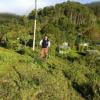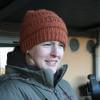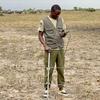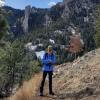Animal movement technologies have already significantly advanced our understanding of the natural world, from uncovering previously mysterious migration patterns and key movement corridors to demonstrating the impacts of anthropogenic pressures and climate change. Continuing advances in the development of technologies for collecting and transmitting bio-logging data, combined with the increased availability of high-resolution environmental data and analytical developments in movement modelling, are opening doors to novel applications. However, there are still major gaps in the space, including mobilizing movement data to translate data from tracking devices into insights for application in policy and practice. This group is a place for the animal movement community to connect and discuss our efforts to advance the field.
Resources for beginners
Learn about WILDLABS Animal Movement research projects
- MoveBON Initiative Announcement
- MoveBON Follow-Up Discussion
- Virtual Meetup Season 4: Tracking Progress (A WILDLABS research project on movement ecology)
Group curators
- @TaliaSpeaker
- | She/her
WILDLABS & World Wide Fund for Nature/ World Wildlife Fund (WWF)
I'm the Executive Manager of WILDLABS at WWF



- 23 Resources
- 64 Discussions
- 31 Groups
- @lhughey
- | she/her
Smithsonian Conservation Biology Institute
I am an ecologist and program manager with experience leading collaborative research projects in international settings. I specialize in the application of animal tracking data to conserve migratory species on a changing planet.



- 6 Resources
- 10 Discussions
- 3 Groups
No showcases have been added to this group yet.
WILDLABS & Wildlife Conservation Society (WCS)
I'm the Bioacoustics Research Analyst at WILDLABS. I'm a marine biologist with particular interest in the acoustics behavior of cetaceans. I'm also a backend web developer, hoping to use technology to improve wildlife conservation efforts.





- 40 Resources
- 38 Discussions
- 33 Groups
R & D Tech | Industrial Designer | Wildlife Management Technology



- 0 Resources
- 93 Discussions
- 6 Groups
- @YvanSG
- | he/him
Clemson University
Seabird ecologist at Clemson University, South Carolina Cooperative Fish and Wildlife Research Unit. Co-chair of Caribbean Seabird Working Group. Porteur de béret occasionel.



- 0 Resources
- 62 Discussions
- 7 Groups
- @carlybatist
- | she/her
ecoacoustics, biodiversity monitoring, nature tech



- 113 Resources
- 361 Discussions
- 19 Groups
- @Ebennitt
- | She/her
Working primarily in Botswana and other southern African countries, on wild mammal movement, ecology and physiology


- 1 Resources
- 9 Discussions
- 5 Groups
- @alexreyyap
- | Male
I am embedded AI systems developer based in Davao City, Philippines.
- 0 Resources
- 0 Discussions
- 5 Groups
- @TaliaSpeaker
- | She/her
WILDLABS & World Wide Fund for Nature/ World Wildlife Fund (WWF)
I'm the Executive Manager of WILDLABS at WWF



- 23 Resources
- 64 Discussions
- 31 Groups
- @CourtneyShuert
- | she/her
I am a behavioural ecologist and eco-physiologist interested in individual differences in marine mammals and other predators



- 0 Resources
- 12 Discussions
- 10 Groups
- @sam_lima
- | She/her
Postdoctoral Associate studying burrowing owls at the San Diego Zoo Wildlife Alliance


- 0 Resources
- 6 Discussions
- 5 Groups
- @Khairani
- | She/Her
Khairani is a biodiversity conservation researcher specializing in Sumatran elephant ecology and community-based conservation initiatives. Holding a Master’s degree in Tropical Biodiversity Conservation from IPB University and a Bachelor’s degree in Biology Education from the Isl
- 0 Resources
- 0 Discussions
- 2 Groups
- @theindieg
- | he/him
Running a small electronic engineering company focused on large scale sensor networks. We have interest in bioacoustics with bat and bird recorders, as well as a host of environmental sensors.


- 0 Resources
- 16 Discussions
- 6 Groups
- 0 Resources
- 0 Discussions
- 10 Groups
Un ambicioso proyecto internacional está usando transmisores satelitales para monitorear los viajes migratorios de ballenas francas australes, permitiendo entender sus sorprendentes patrones de desplazamiento en tiempo...
7 August 2025
If you're a Post-Doctoral Fellow, a PhD student, or a member of the research staff interested in applying your computational skills to support active research publications, please read on to learn about the Cross-...
5 August 2025
Each quarter, Holohil will be supporting projects by donating up to CAD$2,500.00 toward the purchase of Holohil transmitters. We will also pay all shipping charges (Note: importation duties and taxes are the receiver’s...
4 August 2025
The Marine Innovation Lab for Leading-edge Oceanography develops hardware and software to expand the ocean observing network and for the sustainable management of natural resources. For Fall 2026, we are actively...
24 July 2025
Link
Firetail now features a fresh account over at Bluesky - follow us for updates on animal tracking, bio-logging and, of course, upcoming releases and features!
26 June 2025
Hi together, I am working on detecting causalities between land surface dynamics and animal movement by using satellite-based earth observation data. As this is might be your expertise I kindly ask for your support...
8 May 2025
A Post-Doc position is available to join the team coordinating the Urban Exploration Project – a collaborative initiative in partnership between the University of St. Andrews and the National Geographic Society.
2 May 2025
The Convention on the Conservation of Migratory Species (CMS) is seeking information on existing databases relevant for animal movement. If you know of a database that should be included, please complete the survey to...
30 April 2025
We are hiring for a customer support / marketing specialist.
20 February 2025
We look for a person with programming skills in R and/or Python.
4 February 2025
Are you interested in developing new 3D motion capture techniques to for measuring super fast wildlife like cheetahs? Are you interested in working with fusing exciting technologies such as event cameras, audio and...
3 February 2025
This leads to an exciting blog we did recently, it also includes a spatial map indicating elephant movement tracks of an orphaned elephant who self released himself into the wild (Kafue National Park). Cartography was...
28 January 2025
August 2025
event
September 2025
event
event
October 2025
event
November 2025
event
August 2025
event
July 2025
event
100 Products
Recently updated products
| Description | Activity | Replies | Groups | Updated |
|---|---|---|---|---|
| Hi thereI am working with a small dendrobatid amphibian population living in tree tops in Panama, less than 30 mm SVL, and I want to... |
|
Animal Movement | 19 minutes 18 seconds ago | |
| Hi Emily, Timelord and @Rob_Appleby might help: |
|
Animal Movement | 1 day 13 hours ago | |
| 🐝 Apis Nomadica Labs: Mapping Royal Jelly Terroir Through Mobile Bee BiotechAbout Us:Apis Nomadica Labs is a mobile apiary research... |
|
Acoustics, Conservation Tech Training and Education, Animal Movement, Human-Wildlife Coexistence | 6 days 6 hours ago | |
| You could just throw out that data, but I think you'd be doing yourself a disservice and missing out on some interesting insights. Are you training the AI with just pre-COVID... |
|
AI for Conservation, Animal Movement, Data management and processing tools, Human-Wildlife Coexistence | 1 week 4 days ago | |
| Wonderful video! Really impressive :) |
|
Animal Movement, Human-Wildlife Coexistence, Latin America Community | 6 months 1 week ago | |
| Thank you. A couple of things I've done in getting a completely different GPS logging system running.I do use a local clock to keep local time when the GPS is off. ... |
|
Animal Movement | 2 weeks 2 days ago | |
| Thanks @Adrien_Pajot, we are! Also buoys! |
|
Acoustics, Animal Movement | 1 month 1 week ago | |
| I create ocean exploration and marine life content on YouTube, whether it be recording nautilus on BRUVs, swimming with endangered bowmouth... |
|
Acoustics, AI for Conservation, Animal Movement, Camera Traps, Citizen Science, Drones, Emerging Tech, Marine Conservation, Sensors, Sustainable Fishing Challenges, Wildlife Crime | 1 month 2 weeks ago | |
| Hi Craig, I have had the chance to look more closely into your TagRanger product and the information that is available also here on WildLabs. I would definitely be interested... |
+10
|
Animal Movement | 1 month 2 weeks ago | |
| Thank you for your reply, ChadI meant 10 as a whole, indeed. Perhaps you see your post in one group, but since it is tagged for all groups, I assumed you meant 10 in total.In your... |
|
Acoustics, AI for Conservation, Animal Movement, Camera Traps, Citizen Science, Climate Change, Community Base, Connectivity, Drones, eDNA & Genomics, Emerging Tech, Funding and Finance, Geospatial, Human-Wildlife Coexistence, Software Development, Wildlife Crime | 1 month 3 weeks ago | |
| Thanks Fadhilla! I met with your colleague Henrick at the booth. :-) |
|
AI for Conservation, Animal Movement, Camera Traps, Citizen Science, Community Base, Data management and processing tools, Early Career, Geospatial | 1 month 3 weeks ago | |
| Hi everyone,I am working in a national park where a local NGO is soon to be setting up a LoRaWan gateway mainly for monitoring animal... |
|
Animal Movement | 2 months 1 week ago |
Advice and cooperation for small amphibian movement transmiter
13 August 2025 3:13pm
Programmable drop-off units
12 August 2025 11:18am
Siguiendo Ballenas: rastreo satelital desde el espacio revela sus rutas migratorias // Tracking right whales from outer space reveals their migratory routes
7 August 2025 10:26pm
Apis Nomadica Labs: Mobile Bee-Search for the Future of Food & Medicine
7 August 2025 8:23am
Tech4Nature Presents: 2025 Innovation Challenge Workshop Series - Registration Now Open!
6 August 2025 5:09pm
Tech4Nature Presents: 2025 Innovation Challenge Workshop Series - Registration Now Open!
6 August 2025 5:09pm
Tech4Nature Presents: 2025 Innovation Challenge Workshop Series - Registration Now Open!
6 August 2025 5:08pm
Collaborate on Conservation Tech Publications With HAAG
5 August 2025 11:46pm
CAD$2,500.00 toward the purchase of Holohil transmitters
4 August 2025 10:52am
How do you tackle the anomalous data during the COVID period when doing analysis?
21 July 2025 8:55am
25 July 2025 3:06pm
To clarify, are you talking about a model that carries out automated detection of vocalizations? or a model that detects specific patterns of behavior/movement? I would suspect that the former is not something that may be impacted while training as the fundamental vocalizations/input is not going to change drastically (although see Derryberry et al., where they show variation in spectral characteristics of sparrows at short distance pre and post-covid lockdowns).
28 July 2025 6:14pm
I'm specifically referring to movement of animals affected by anthropogenic factors. My question has nothing to do with vocalisations.
Humans were essentially removed from large sections of the world during covid and that surely had some effects on wildlife movements, or at least I am assuming it did. But that would not be the regular "trend". If I try to predict the movement of a species over an area frequented by humans, that surely comes into the picture - and so does their absence.
My question is very specific to dealing with data that has absence (or limited interference) of humans during the covid period in all habitats.
1 August 2025 10:24pm
You could just throw out that data, but I think you'd be doing yourself a disservice and missing out on some interesting insights. Are you training the AI with just pre-COVID animal movement data or are you including context on anthropogenic factors as well? Not sure if you are looking at an area that has available visitor/human population data, but if you include that with animal movement data across all years it should net out in the end.
WILDLABS AWARDS 2024 - Innovative Sensor Technologies for Sustainable Coexistence: Advancing Crocodilian Conservation and Ecosystem Monitoring in Costa Rica
11 July 2024 11:30pm
14 December 2024 6:41pm
¡Muchas gracias @vanereyes, apreciamos su apoyo!
4 February 2025 11:44am
Super interesting! I'm currently developing sensor accelerometers for fence perimeters in wildlife conservation centres. I think this is a really cool application of accelerometers; I would love to know how the sensor which you developed for part 3 looked like, or what type of software/machine learning methods you've used? Currently my design is a cased raspberry pi pico, combined with an accelerometer and ml decision trees in order to create a low-cost design. Perhaps there is something to be learnt from this project as well :)
4 February 2025 2:45pm
Wonderful video! Really impressive :)
Seeking Input: GPS Fix Interval Methodology for Wildlife Tracking Collars
19 July 2025 12:01am
27 July 2025 2:08am
Hi Marlene.
One possibility might be to use the GPS time to synchronize an on-board real time clock (RTC). This configuration would be a "GPS disciplined clock" where the GPS would be used to adjust the time, but the actual timekeeping happens on the real time clock. This would eliminate the drift since the interval would come from an alarm or timer from the offline RTC and would hence continue to work in areas like a den or in dense foliage where it would be difficult to get a GPS fix.
27 July 2025 2:17am
FYI if you really want to go down a timekeeping rabbit hole, check out the Leap Second website. There are a lot of fascinating things you can do with precision timekeeping.
28 July 2025 1:32am
Thank you. A couple of things I've done in getting a completely different GPS logging system running.
I do use a local clock to keep local time when the GPS is off. Each time the GPS comes on and finally gets a fix, I reset the local clock. The alarm function is then based off of the local clock rather than the GPS. At least for the chipset I use, the local clock remains running even when in sleep or power down mode and draws very little power.
Another way you might attack the problem if so you want 1 hour fixes, is to set the alarm for 50 minutes, leaving the GPS on just long enough to get a clock fix and then sleep for the calculated time it takes to get the on-the-hour fix. I've found that with GPS modules with memory backup (usually a supercap or second small battery), the second fix will be pretty quick, so although there is more power consumption, it's not double what a single fix would be.
Anyway, it's an interesting problem. Let us know how you elect to address it.
Chris H
MS and PhD Opportunities in Ocean Engineering and Oceanography (Fall 2026)
24 July 2025 5:55am
Acoustic recording tags for marine mammals (soundscape research)
5 June 2025 6:04pm
30 June 2025 3:36pm
Hi There!
For biologgers, I think there are a few on the market that have been attached to marine mammals. I've provided a few links to ones that I know have been used for understanding the behavioural responses to sound - Dtags made by SMRU and Acousonde tags.
You could also have a look through The Inventory here on WildLabs for other devices on the market.
Hope that helps!
Courtney
3 July 2025 9:08am
Hey Maggie,
@TomKnowles and his team, 2025 awardees, are working on a acoustic tags to be deployed Basking Sharks!
3 July 2025 7:22pm
Thanks @Adrien_Pajot, we are!
Also buoys!
I WANT TO TELL YOUR STORY
29 June 2025 10:22am
Low-cost GPS tracking of giant tortoises
27 April 2025 7:35am
19 June 2025 1:03pm
There is a mast, yes, and it is being tested at the moment. It seems to be working fine but at the moment I am not 100% sure it will remain on. But lets hope so
20 June 2025 12:57pm
Hi Fadhilla,
Thank you so much for reaching out to me. I am interested and will contact you via email.
Thanks again,
Lisa
27 June 2025 11:47am
Hi Craig,
I have had the chance to look more closely into your TagRanger product and the information that is available also here on WildLabs. I would definitely be interested as it seems to be a perfect fit for what I would like to do.
I read that you have been doing a trial with tracking tortoises. I would be interested to know where that project is, if you dont mind me asking, please. I currently working in Seychelles with Aldabra Giant Tortoises and it would not surprise me if the project is here... If so, I would try and reach out to hear about that projects' experience, particularly with tracking tortoises.
One question I did not find the answer to: does the TagRanger also record any enviornmental variables such as temperature?
Firetail on Bluesky
26 June 2025 1:44pm
New Group Proposal: Systems Builders & PACIM Designers
18 June 2025 2:52pm
19 June 2025 9:08am
Hi Chad,
Thanks for the text. As I read it, PACIMs play a role in something else/bigger, but it doesn't explain what PACIMs are or what they look like. Now I've re-read your original post, I'm thinking, maybe I do understand, but then I feel the concept is too big ( an entire system can be part of a PACIM ? ) to get going within a WildLabs group. And you want to develop 10 PACIMS within a year through this group? Don't get me wrong, I am all for some systems change, but perhaps you're aiming too high.
19 June 2025 12:19pm
Hello again sir - PACIMs really mean 'projects' is the way I see it. Each part of the acronym can be seen as a project (if you have an assignment to do, you have a project really).
As for your query on 10 projects in 'this' group - I should ask for clarification if you mean particularly acoustics or in any group (I see now this is the acoustics thread after I selected all the groups for this post). If you are asking on acoustics, you're right - I am unsure on 10 as I am not too keen on acoustics yet. If you are asking 10 projects as a whole like 10 projects in the funding and finance group - I believe 10 to be a very reasonable number. Our projects we have co-created are for the most part replicable, rapidly deployable, quickly scalable, fundable through blended finance and more.
Thank you again for the feedback.
19 June 2025 1:43pm
Thank you for your reply, Chad
I meant 10 as a whole, indeed. Perhaps you see your post in one group, but since it is tagged for all groups, I assumed you meant 10 in total.
In your first post you explain PACIM stands for "Projects, Assignments, Campaigns, Initiatives, Movements, and Systems", so I understood it as more than just projects. Obviously, many things can be packed into a project or called a project, but then, what does it mean that 'Projects' is part of the list?
Well, if you think 10 projects is doable, then don't let me stop you.
ICCB 2025 – Let’s Connect!
9 March 2025 5:06am
16 June 2025 8:33am
Hey Stephanie,
I have dropped you couple of links. I believe we also have a booth somewhere.
16 June 2025 8:41am
Hi Stephanie,
It’s great to hear about your exciting work and that you’ll be attending ICCB 2025 — congratulations on presenting!
The Savannah Tracking team is participating at the exhibition, and we’d love for you to stop by our booth 15.
Given your previous interest in collaring domestic dogs and collecting high-resolution GPS data, it might be a great opportunity for us to connect in person and dive deeper into how our lightweight collar solutions — like those currently deployed on Dingoes — could support your project. We'd be happy to show you how our satellite-enabled collars work, demo our data platforms, and explore a potential fit for your needs.
19 June 2025 7:34am
Thanks Fadhilla! I met with your colleague Henrick at the booth. :-)
LoRa-GPS for small mammals
2 June 2025 6:04am
AfriMove
6 March 2025 8:09am
Application deadline for Animove, 31May2025
27 May 2025 10:24am
Agent Based Modelling Advice
5 May 2025 3:23pm
19 May 2025 5:05pm
Thanks for the reply Alan.
The research question is:
If I modify the infrastructure (roads, wildlife crossings, fences, water features etc basically any geospatial feature) in the environment can we predict where the deer/elk will move to based on those modifications?
The goal is to prototype the new layout/features of an area that contains a large road to establish the best measures (wildlife crossings, fences) and placement to prevent elks crossing the large road as much as possible. The team want to minimize vehicle collisions.
The second order effects are also interesting. If we close off an area they are used to going, does that change where they go, and if so, where?
22 May 2025 2:31pm
Hi David,
I would reiterate what Alan has said here - there is no concrete "right" or "wrong" way! It can be really helpful if you have animal movement data, particularly if it's from the area you'd like the model to emulate, but not a requirement.
Based on the question you're asking, you could analyze the deer data you have to determine how different variables influence their movement, which you could then use to set some of the rules for your model. I would note that deer and elk can move across a landscape quite differently, so if you have a species mismatch this might not be the best approach. I have taken this approach for some models, but I have also built others where the rules were entirely based on information pulled from an in-depth literature review. All of my models deal with large mammals (deer, elk, cattle, wolves, etc.).
One of the biggest things you'll have to decide is which/how many rules and parameters you want to include in the model, because you can end up with a long list rather quickly, making the model complex and heavy. How you set up your rules and parameters will also depend on the scale, of your model, of course. Behaviors and movement decisions appear differently at an hourly, daily, weekly scale across meters, kilometers, etc. so you'll want to account for that.
Good luck!
Vivian
22 May 2025 8:59pm
Hi Vivian,
Thank you so much for your reply! I appreciate the pointers on species mixing, to clarify: I have been experimenting with deer data, but for once the project is underway I will be given access to lots of elk data, which I would then use for the elk simulation. The elk data will be from the location of interest.
A few questions if you have time...
- When you say 'model', do you mean an AI model, or do you mean a more general take: a set of programmatic rules you have encoded to control the agent?
- Similar to above, when you say 'analyze the data', are you manually extrapolating rules from looking at charts you make of the data, or are you selecting data parameters for funnelling into a machine learning model?
- When you say account for different time/distance scales, are you suggesting that looking at immediate next move is not sufficient and I need a second "layer" for agent decision-making which might be about seasonal drivers, or at least next move is date/season aware?
- In the models you have made are you ever encoding rules as "forces"?.. some things attract the animal to move to it, other things repel the animal to move away from it and the animal moves based on all the "forces" combined?
I have more questions, like whether you include feeding or memory in the agent, if you primarily examine land type it is on and can move to, topography... but the 4 listed questions will give me a great starting point.
If you have any good examples/literature for elk/deer on movement models I would love to take a look.
Thank you so much!
David
PhD Advice
22 April 2025 1:34am
4 May 2025 4:14pm
Hi @ethanmarburger, I am probably not the best to give advice here given that it took me nearly two decades to actually finish my PhD, but I'd aim for something that you are really interested in so that you can keep up a high momentum. If you love your project you are more likely to cruise through the 'grind' periods. In terms of networking, WILDLABS is definitely a great place to start! You may well find some connections just looking across the threads here, and reaching out to people that are doing work you are interested in. More broadly, and depending on where you are in the world, you might be able to volunteer or even get some work on projects in your area, which can be a good way to get a foot in the door to larger research projects. You could possibly look at helping out on some analysis of spatial/AI datasets etc, or reach out to not-for-profits and conservation charities and see what they need/you might be able to help with - but try and be as specific as possible so they know straight away what you are after. Just a few quick ideas off the top of my head, and more than happy to discuss further. My best for your search!
Cheers,
Rob
19 May 2025 12:29am
Hi Ethan, It's indeed a competitive area. My advice for you (and anybody else seeking a PhD supervisor)...
- Do background research on each individual potential supervisor and always approach them demonstrating your alignment with their research focus.
- Show that you have read and understood one or two of their key (relevant) papers in your initial email to them.
- Have in mind something relevant to you AND to the potential supervisor, to propose as a topic in your initial email to them. But, remain open to their ideas - there's a good chance they have something that would align with your interests and that would (more) smoothly generate a successful PhD than you might have come up with ;-)
- Write clearly and succinctly.
- Demonstrate enthusiasm and highlight any relevant past experience and engagement in the relevant area (briefly).
- Attach a PDF CV.
- Apply for PhD positions in areas where you are qualified.
- Evidence that you have published a good paper, especially as first author, from your Masters thesis would be a bonus.
This is a time-consuming process. But you may end up spending 3+ years working with this supervisor, and vice versa. It's important for all concerned that you (and they) make a good, informed decision.
Good luck in your search!
Alan.
AniMove Summer School 2025Application deadline: 31.May 2025
21 May 2025 1:08pm
27 May 2025 10:20am
NASA webinar on animal tracking + remote sensing
16 May 2025 6:06pm
The Boring Fund 2024 - MoveApps
17 January 2025 12:54pm
2 April 2025 12:15pm
We are pleased to inform you that we have now finalized point 2 and 3. Here some details of the update:
- App browser improvements:
- Improved overview and search: we have added a description of each category and
the search and filtering options are improved. Searching for Apps within a Workflow: we have added the option to include Apps
that are not compatible with the IO type, making it easier to decide if a translator
App is needed to include one of the incompatible Apps.
- Improved overview and search: we have added a description of each category and
- Public Workflows improvements:
- Improved overview: the public Workflows are now organized by categories which
can be also used for filtering. - More information: the details overview contains now the list of Apps included in
each Workflow. - Sharing Workflows: when creating a public Workflow you will have to select one
or more existing categories, but you can also always request a new category.
- Improved overview: the public Workflows are now organized by categories which
Go and check it out in MoveApps!
4 April 2025 2:53pm
That's so great, thanks for the update!
16 May 2025 12:20pm
We are please to inform that we have implemented the point 1 and 4 and with this have finalized the project. The latest improvements:
- Improvement in findability of help documentation: we have started to populate the platform with links (question mark icon) to the relevant
sections of the user manual. - The log files of each App can now be downloaded and when an error occurs directly be sent to MoveApps support. Find more details here.
Again a great thank you for giving us the opportunity to implement these changes. We think they have greatly improved the user friendliness of MoveApps
Please take 2-minute survey on undergraduate education in Movement Ecology
13 May 2025 9:37am
Survey on Earth Observation in Wildlife Ecology
8 May 2025 12:42pm
Prospective NSF INTERN
11 February 2025 10:00am
8 May 2025 8:51am
My name is Frank Short and I am a PhD Candidate at Boston University in Biological Anthropology. I am currently doing fieldwork in Indonesia using machine-learning powered passive acoustic monitoring focusing on wild Bornean orangutans (and other primates). I am reaching out because as a student with a National Science Foundation Graduate Research Fellowship, I am eligible to take advantage of the NSF INTERN program which supports students to engage in non-academic internships through covering a stipend and other expenses, with the only caveat being that the internship must be in-person and not remote. I was wondering if any organizations in conservation technology would be interested in a full-time intern that would be coming in with their own funding?
In addition to experience with machine learning and acoustics through training a convolutional neural network for my research, I also have worked with GIS, remote sensing, and animal movement data through other projects. Further, I have experience in community outreach both in and outside of academic settings, as I previously worked for the Essex County Department of Parks and Recreation in New Jersey for 3 years where I created interpretive signs, exhibits, newsletters, brochures, and social media posts. Now while doing my fieldwork in Indonesia, I have led hands-on trainings in passive acoustic monitoring placement and analysis as well as given talks and presentations at local high schools and universities.
I would love to be able to use this opportunity (while the funding still exists, which is uncertain moving forward due to the current political climate in the US) to exercise and develop my skills at a non-academic institution in the conservation technology sphere! If anyone has any suggestions or is part of an organization that would be interested in having me as an intern, please contact me here or via my email: fshort@bu.edu geometry dash. Thank you!
Hi Frank, your work sounds incredibly valuable and well-aligned with current needs in conservation tech. With your strong background in machine learning, acoustics, GIS, and outreach, you’d be an asset to many organizations. I’d recommend looking into groups like Rainforest Connection, Wildlife Acoustics, or the Conservation Tech Directory (by WILDLABS)—they often work on acoustic monitoring and might be open to in-person internships, especially with funding already in place. Best of luck finding the right match—your initiative is impressive!





























































12 August 2025 2:29pm
Hi Emily,
Timelord and @Rob_Appleby might help: